When hibernation is enabled in Windows 10, the OS creates a file called hiberfil.sys in the root of your C: drive. Also, there is a feature called Fast Startup to speed up the boot process. When enabled, it makes Windows boot very fast. The operating system uses a hybrid shutdown which writes the memory occupied by the OS kernel and loaded drivers to the C:\hiberfil.sys file.
Advertisеment
By default, the hiberfil.sys file is not visible in File Explorer. You need to change its options to see the file. For reference, see the article
How to Show Hidden Files in Windows 10
Depending on the size of the RAM installed in your computer, the hiberfil.sys file might reach several GBs in size. It can be a very big file. If you need to free up your system drive's space quickly or if you are running low on disk space and this prevents you from finishing your tasks, you can delete the hiberfil.sys file. First of all, you should check out if it is worth proceeding. Here is how to find the current size of the hibernation file. Do the following.
Find the size of the hiberfil.sys file
- Open File Explorer.
- Navigate to the root of your system drive, usually C:.
- Click on File - Options.
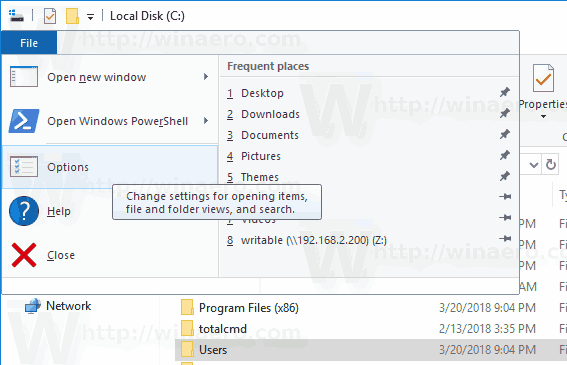
- Go to the View tab.
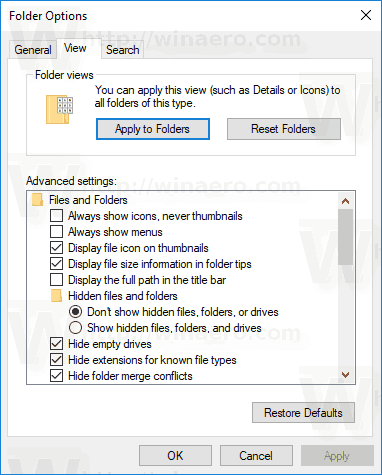
- Turn on the option Show hidden files, folders, and drives.
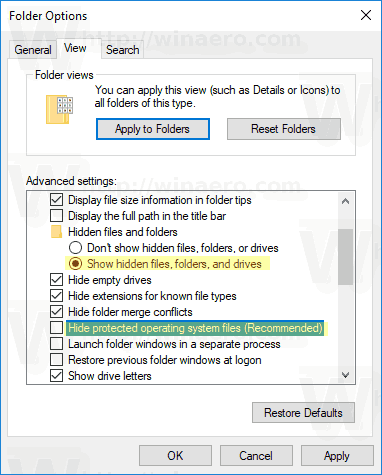
- Now, uncheck the option Hide protected operating system files.
- Windows now shows the hiberfil.sys file and its size.
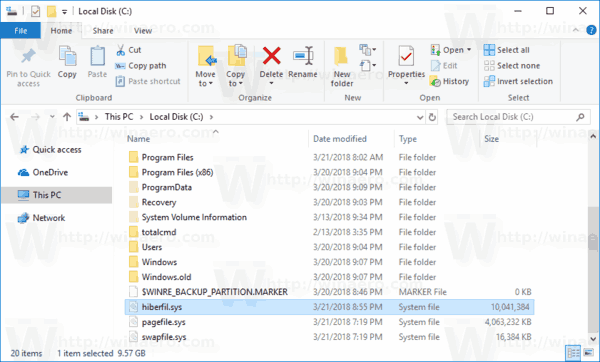
How to Delete Hiberfil.sys (Hibernation) File in Windows 10
The only way to delete the hiberfil.sys system file is to disable the hibernation feature. Personally, I find hibernation very useful, so I recommend you disable it only as a temporary solution to free up a considerable amount of disk space. Once you complete your tasks, consider enabling it again. This will restore the hiberfil.sys file.
To delete the hiberfil.sys (Hibernation) file in Windows 10, do the following.
- Open the command prompt as Administrator.
- Type the following command:
powercfg -h off.
- The hiberfil.sys hibernation file is now deleted.
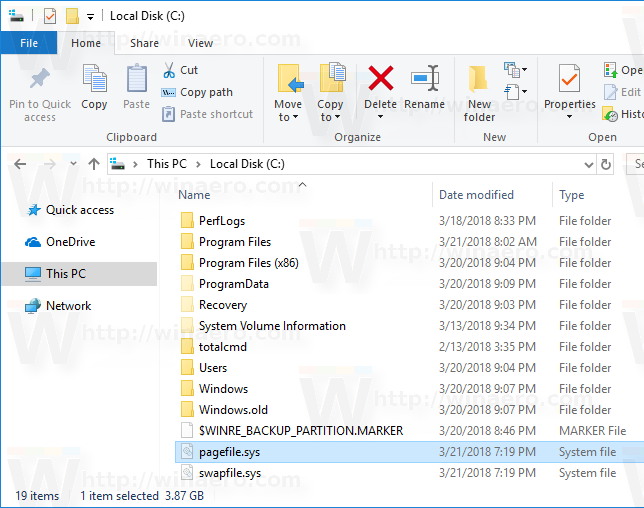
- Complete your tasks and enable hibernation by running the command
powercfg -h onin the command prompt.
You are done.
There are a number of tweaks you can apply to the hibernation file in Windows 10. Refer to the following articles.
- Disable Hibernation but Keep Fast Startup
- Compress Hibernation File in Windows 10
- Reduce hibernation file (hiberfil.sys) size in Windows 10
That's it.
Support us
Winaero greatly relies on your support. You can help the site keep bringing you interesting and useful content and software by using these options:

Good tip. I think Windows enable it again after each feature update though, so you might have to do it again after?
Also, during testing on computers that are a bit fast with SSDs, I found that disabling fast boot made the computer actually boot faster, plus it gives you a real clean start every time you boot, which could maybe reduces the risk of issues. It also makes the computer shutdown faster as well.
For this reason, I always deactivate hibernation and fast boot. The normal sleep mode already uses a very low amount of power, no need for hibernate for many.
I agree with Joe…..I work in IT at a financial institution and fix computers for a living. Personally I always disable Fast Startup and Hibernation if running a SSD or M.2 Hard Drives as they are already superfast and you gain next to nothing. I find many strange issues with booting and shutting down solved by disabling both.
Agree with comment above and would like to add that it’s best to disable it and fast startup if you’re multibooting with Linux and require read/write access to your NTFS drives (problems will occur at some point). Hiberation can be useful, but so is shutting down cleanly. Fast startup is problematic, it can also be called slow shut down or strange lingering restarts and I wouldn’t use it even if I was using Windows exclusively. All system drives are SSD and pretty cheap (in price) and start up, shut down or restart happens in a in a predictable few seconds with it disabled.
” An unexpected error (0x65b) has occurred: Function failed during execution.” What do I do?
This does not remove the Hiberfil.sys file that is on a secondary drive. I used to have 2 different instances of Windows 10 that were run from their own physical hard drives. I stopped using the second copy of Windows 10 a couple of years ago, but kept the hard drive and its accessible from my current Windows 10. I cannot delete the Hiberfil.sys file no matter what I do. The second copy of Windows 10 is not bootable anymore, How can I remove the Hiberfil.sys file short of formatting the drive?
Try a bootable USB stick. On the Setup’s welcome screen, press Shift+F10 and type
attrib -h -s -r d:\hyberfil.sysdel d:\hyberfil.sys. Change the path to your file if needed.